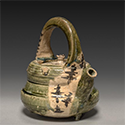|
|
| Show All 30 Results (Text Only) |
|
| Art of the Samurai: Japanese Arms and Armor, 1156–1868 |
|
| The Metropolitan Museum of Art
|
Online presentation of a 2009-2010 exhibition, the "first comprehensive exhibition devoted to the arts of the samurai" and "the first exhibition ever devoted to the subject of Japanese arms and armor conservation." With images of 27 objects.
Go to Museum Resource: https://www.metmuseum.org/exhibitions/listings/2009/art-of-the-samurai/photo-ga... | |
|
|
| Arts of the Samurai [PDF] |
|
| Asian Art Museum of San Francisco
|
"The term samurai is derived from the word saburau, or “one who serves.” The evolution of the samurai from mounted guards to the nobility (during the twelfth century) and their subsequent ascent to military leaders of Japan (until imperial restoration during the nineteenth century) is chronicled in distinctive warrior arts and literary tradition. This packet examines the samurai through precious art objects from the museum’s collection. These include authentic military equipment (arms and armor), paintings depicting famed conflicts, ceremonial attire, and objects created for religious and cultural pursuits strongly connected with the samurai class."
Go to Museum Resource: https://education.asianart.org/wp-content/uploads/sites/6/2019/12/ArtsofSamurai... | |
|
|
| The Asian Art Digital Teaching Project: Japan |
|
| Columbia University, Media Center for Art History
|
A module for "classroom presentation or student study" of two important scrolls from the Kamakura Period – Illustrated Legends of the Kitano Shrine (Kitano Tenjin Engi) and Illustrated Sutra of the Miracles of Kannon.
Go to Museum Resource: http://www.learn.columbia.edu/nehasian/html/neh_geo_con_japan.html | |
|
|
|
| Bu and Bun: The Arts of War and Peace |
|
| Asian Art Museum of San Francisco
|
In addition to superior strategic and military ability, most elite samurai were expected to be versed in the cultural arts. The warrior’s ideal balance of military and artistic skill is captured well in this description of the sixteenth century daimyo Hosokawa Yusai (1534–1610): “Renowned for his elegant pursuits, he is a complete man combining arts [bun] and arms [bu]. A man of nobility, a descendant of the sixth grandson of the emperor Seiwa, he was a ruler endowed with awesome dignity and inspiring decorum…He built a splendid castle, which was majestic, beautiful and high…He discussed Chinese poetic styles and recited by heart the secret teachings of Japanese poetry…" See also Archery Practice.
Go to Museum Resource: https://education.asianart.org/resources/bu-and-bun-the-arts-of-war-and-peace/ | |
|
|
| Chado: The Japanese Tea Ceremony |
|
| The Cleveland Museum of Art
|
This lesson introduces students to the Japanese tea ceremony to consider the art and the tradition of the tea ceremony and study the serving pieces used in the ceremony by participating in a tea ceremony. Students will learn the importance of the performance of tea ceremony through the history of how it became what it is today.
Go to Museum Resource: http://www.clevelandart.org/lesson-plan-packet/chado-japanese-tea-ceremony | |
|
|
| Courtship and Calligraphy in “The Tale of Genji” |
|
| The Cleveland Museum of Art
|
The purpose of this lesson is to discover through an examination of The Tale of Genji and other Japanese literature, the importance of calligraphy to courtship rituals in the Japanese court culture of the late Heian period (794-1185).
Go to Museum Resource: http://www.clevelandart.org/lesson-plan-packet/courtship-and-calligraphy-tale-g... | |
|
|
| Getting Started with Zazen (Seated Meditation) |
|
| Asian Art Museum of San Francisco
|
In Zen Buddhism, zazen (pronounced: zah-zen) is a sitting meditation. Zazen is not focusing on a specific object or thought. Instead, it is the liberating of one’s mind of all thought into a state of emptiness (a complete emptiness that is also complete fullness) from which the practitioner hopes to experience spontaneous awakening to the inner self (enlightenment). Download Includes a glossary.
Go to Museum Resource: https://education.asianart.org/resources/getting-started-with-zazen-seated-medi... | |
|
|
|
| Show All 30 Results (Text Only) |









